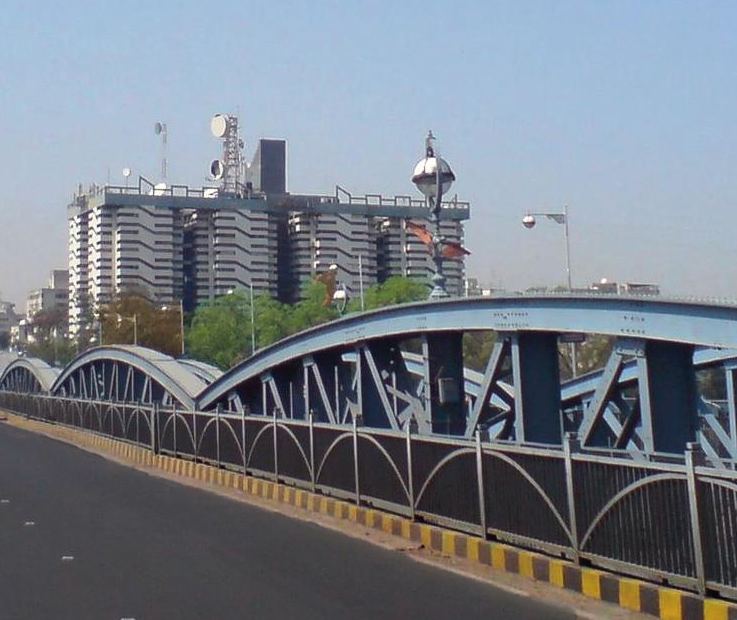Carries Road traffic Total length 480 m Opened 1892 | Crosses Sabarmati River Construction started 1889 Location Ellis bridge | |
 | ||
Official name Swami Vivekananda Bridge Heritage status Protected site since 1989 Similar Vatva railway station, Kankaria Lake, Sarkhej, Ashram Road, Shah‑e‑Alam's Roza | ||
Ellis bridge a century old heritage bridge ahmedabad
Ellis Bridge is a century old bridge situated in Ahmedabad, Gujarat. It bridges the western and eastern parts of the city across the Sabarmati river. This bowstring arch truss bridge was the first bridge of Ahmedabad constructed in 1892. Later new concrete wings were constructed on either side in 1997 and it was renamed as Swami Vivekananda Bridge but is still known to people by its old name.
Contents
- Ellis bridge a century old heritage bridge ahmedabad
- Ellis bridge in ahmedabad gujarat
- History
- Reconstruction proposal
- Cultural significance
- References
Ellis bridge in ahmedabad gujarat
History
The original wooden bridge was constructed by British engineers in 1870–71 at a cost of £54,920 (Rs. 5,49,200). Except two spans on banks, It was destroyed by floods in 1875. A new steel bridge was rebuilt in 1892 by engineer Himmatlal Dhirajram Bhachech and named after Sir Barrow Helbert Ellis, the commissioner of the North Zone. The steel was imported from Birmingham. Himmatlal built it at a cost of Rs 407,000 which was lower than the budget of Rs 500,000. The Government grew suspicious and thought that low quality materials were used by Himmatlal. An inquiry committee was set up and it found that the construction was of superior quality. For saving the Government money, Himmatlal was subsequently honoured with title of Rao Sahib.
The Foundation Block of Ellisbridge was later moved to the Sanskar Kendra. It reads, The Ellis Bridge - So named by Government after Sir Barrow Helbert Ellis : K.G.S.I. was built in 1869 and 1870. At a cost of Rs:549,210 destroyed by the great flood of 22 September 1875 and rebuilt in 1890 and 1895 by Government, Local Bodies and Private Subscribers. At a further cost of Rs. 407,564. This the First Stone of the new bridge was laid by His Excellency Donald James eleventh Lord Reay C.C.I.E.LL.D. Governor of Bombay 19 December 1889.
Thousands heard Mahatma Gandhi declaring his Dandi march on 8 March 1930 from Ellis bridge.
Proposals were made to pull down the bridge in 1973, 1983 and 1986 but all were rejected. Later Ahmedabad Municipal Corporation (AMC) declared Ellis bridge and its boundary, Manek Burj and the natural water drain near one of the banks of Sabarmati river as protected sites in May 1989.
The original steel bridge was narrow and not suited for heavy motorized traffic and so it was closed in 1997. New concrete bridges were constructed on either side of the steel bridge to support heavy traffic in 1999 at cost of Rs 180 million, and the original steel bridge is preserved as a heritage landmark. After the documentation, the Manek Burj was partially removed and Ganesh Bari, the Maratha constructed gate, was reconstructed to make space for the bridge. The bridge has been renamed as Swami Vivekananda bridge after Swami Vivekanand.
Reconstruction proposal
It was found that steel piers of the bridge got corroded due to pollution in the Sabarmati river. Consultants appointed for strengthening the bridge, proposed its demolition in 2012 since building a new bridge would be cheaper than strengthening the existing one. It was also planned to run the BRTS buses on the new bridge. It is proposed that the steel arches of the old steel bridge should be preserved and placed back on the new bridge. Later AMC shelved proposal of new bridge for BRTS.
Cultural significance
This 120-year-old bridge has become an iconic landmark and a symbol of Ahmedabad. It was featured in sevral films such as in Kai Po Che! (2013) and Kevi Rite Jaish (2012). The Karnavati Art Gallery is situated at the western end of the bridge which regularly exhibits art.
